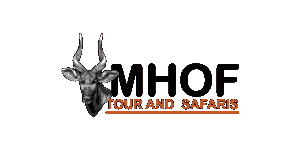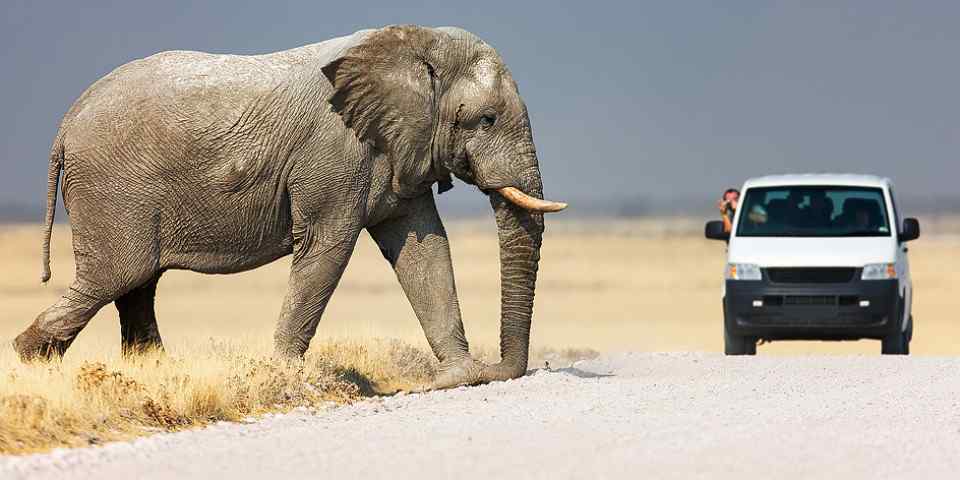Tour Length
Rates in USD $ – Change Currency
Per person, excl. international flightsOperator Rating
Other Tour Features
Filter by Operator
Filter by Accommodation
Etosha Self-drive Safaris & Tours
Etosha National Park in northern Namibia belongs among the elite of southern Africa’s wildlife destinations. The park consists of a series of hallucinatory salt pans that scorch blindingly white in the daytime but turn soft pastel-pink at sunrise and sunset. The salt pans and their arid surrounds provide fascinating habitat for an astonishing array of wildlife: you’ll most likely see elephants caked in the Etosha dust, rhinos gathering around waterholes after dark, and maybe even lions or cheetahs on the hunt while vast herds of impala and zebra mill around nervously nearby. And seeing all of this while on a self-drive safari in Etosha is one of the greatest safari experiences you can have in Namibia.
-
Best Seller
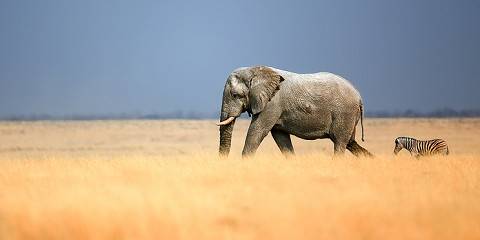
10-Day Classic Namibia
$3,972 to $4,972 pp (USD)
Namibia: Self-drive
Mid-range Lodge & HotelYou Visit: Windhoek (Start), Kalahari Region, Sossusvlei (Sand Dunes), Swakopmund (City), Damaraland, Etosha NP, Okonjima NR, Windhoek (End)

Wayfairer Travel

4.8/5 – 184 Reviews
-
Best Seller
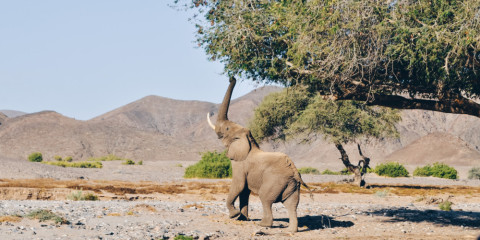
15-Day Eco-Friendly Namibian Self-Drive Safari
$3,977 pp (USD)
Namibia: Self-drive
Mid-range Lodge & Guest HouseYou Visit: Windhoek (Start), Sossusvlei (Sand Dunes), Swakopmund (City), Erongo Mountains (Mountain Range), Damaraland, Palmwag Concession (Damaraland), Etosha NP, Eastern Etosha NP, Windhoek (End)

Viatu
4.9/5 – 93 Reviews
-
Top Rated Operator

12-Day Self-Drive Namibia Attractions Safari
$4,840 pp (USD)
Namibia: Self-drive
Mid-range Lodge & Tented CampYou Visit: Windhoek (Start), Kalahari Region, Namib-Naukluft NP (Namib Desert), Swakopmund (City), Twyfelfontein (Rock Art), Etosha NP, Eastern Etosha NP, Okonjima NR, Windhoek (End)
_774_5c10b301bc706.gif)
Nature Travel Namibia
5.0/5 – 185 Reviews
-
Top Rated Operator
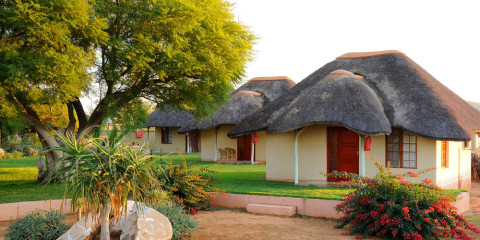
7-Day Namibia - Etosha National Park Self-Drive Safari
$2,099 pp (USD)
Namibia: Self-driveLuxuryLodge
You Visit: Windhoek (Start), Otjiwarongo (City), Etosha NP, Windhoek Airport (End)

MoAfrika Tours
4.9/5 – 2,285 Reviews
-
![7-Day Self Drive - Etosha Animal Kingdom]()
7-Day Self Drive - Etosha Animal Kingdom
$1,483 to $1,555 pp (USD)
Namibia: Self-drive
Mid-range LodgeYou Visit: Windhoek (Start), Okonjima NR, Etosha NP, Eastern Etosha NP, Waterberg Plateau, Windhoek Airport (End)

Desert Air Africa Safaris
5.0/5 – 30 Reviews
-
![9-Day Best of Namibia Self Drive Safari]()
9-Day Best of Namibia Self Drive Safari
$3,948 pp (USD)
Namibia: Self-drive
Mid-range Lodge & Guest HouseYou Visit: Windhoek (Start), Sossusvlei (Sand Dunes), Swakopmund (City), Etosha NP, Okonjima NR, Windhoek (End)

Mhof Tour and Safaris
4.7/5 – 3 Reviews
-
![9-Day Wonders of Namibia Self-Drive]()
9-Day Wonders of Namibia Self-Drive
$2,822 pp (USD)
Namibia: Self-drive
Mid-range Lodge & Guest HouseYou Visit: Windhoek (Start), Sossusvlei (Sand Dunes), Swakopmund (City), Etosha NP, Waterberg Plateau, Windhoek (End)

Africa Zim Travel & Tours
4.9/5 – 162 Reviews
-
![10-Day Best Namibian Attractions Self-Drive Safari]()
10-Day Best Namibian Attractions Self-Drive Safari
$3,361 to $3,705 pp (USD)
Namibia: Self-drive
Mid-range Lodge & HotelYou Visit: Windhoek (Start), Kalahari Desert, Namib-Naukluft NP (Namib Desert), Swakopmund (City), Damaraland, Etosha NP, Okonjima NR, Windhoek Airport (End)

Southbound Tours
5.0/5 – 14 Reviews
-

8-Day Namibia Highlights Self-Drive Tour
$799 to $947 pp (USD)
Namibia: Self-drive
Mid-range Lodge & Guest HouseYou Visit: Windhoek (Start), Sesriem (Town), Namib-Naukluft NP (Namib Desert), Swakopmund (City), Etosha NP, Windhoek (End)

Indigo Safaris
4.8/5 – 158 Reviews
-
![10-Day Namibia Popular Classic Self-Drive Safari]()
10-Day Namibia Popular Classic Self-Drive Safari
$2,073 to $2,264 pp (USD)
Namibia: Self-drive
Mid-range Lodge & Guest HouseYou Visit: Windhoek (Start), Otjiwa Game Farm, Etosha NP, Twyfelfontein (Rock Art), Swakopmund (City), Sossusvlei (Sand Dunes), Windhoek (End)

Jangwa Tours and Safaris
5.0/5 – 8 Reviews
-
![14-Day Namibia Camping Adventure for the Young at Heart]()
14-Day Namibia Camping Adventure for the Young at Heart
$1,397 to $1,722 pp (USD)
Namibia: Self-driveBudgetCamping
You Visit: Windhoek (Start), Otjiwa Game Farm, Onguma GR, Eastern Etosha NP, Western Etosha NP, Erongo Mountains (Mountain Range), Spitzkoppe (Damaraland), Swakopmund (City), Sesriem Canyon (Highlight), Deadvlei (Sand Dunes), Kalahari Region, Windhoek (End)

Firefinch Safaris & Car Hire
5.0/5 – 13 Reviews
-
Top Rated Operator
![19-Day Namibia Self Drive Adventure]()
19-Day Namibia Self Drive Adventure
$9,533 to $10,033 pp (USD)
Namibia: Self-drive
Mid-range Lodge & Tented CampYou Visit: Windhoek (Start), Kalahari Region, Fish River Canyon (|Ai-|Ais/Richtersveld TP), Aus (Town), Namib-Naukluft NP (Namib Desert), Swakopmund (City), Damaraland, Etosha NP, Eastern Etosha NP, Erongo Mountains (Mountain Range), Windhoek Airport (End)

Wayfairer Travel

4.8/5 – 184 Reviews
-

3-Day Eco-Friendly Etosha Self-Drive Safari
$421 pp (USD)
Namibia: Self-driveLuxuryLodge
You Visit: Windhoek (Start), Etosha NP, Windhoek Airport (End)

Viatu
4.9/5 – 93 Reviews
-
Top Rated Operator

12-Day Self-Drive Northern Namibia Safari
$3,631 pp (USD)
Namibia: Self-drive
Mid-range Lodge & Guest HouseYou Visit: Windhoek (Start), Sesriem (Town), Sossusvlei (Sand Dunes), Swakopmund (City), Damaraland, Etosha NP, Otjiwarongo (City), Windhoek Airport (End)

MoAfrika Tours
4.9/5 – 2,285 Reviews
-
![12-Day Classic Namibia Self Drive Tour]()
12-Day Classic Namibia Self Drive Tour
$5,047 to $5,618 pp (USD)
Namibia: Self-drive
Mid-range Lodge & Tented CampYou Visit: Windhoek (Start), Sossusvlei (Sand Dunes), Swakopmund (City), Twyfelfontein (Rock Art), Etosha NP, Eastern Etosha NP, Waterberg Plateau, Windhoek (End)

Desert Air Africa Safaris
5.0/5 – 30 Reviews
-
![12-Day Best of Namibia Self Drive Safari]()
12-Day Best of Namibia Self Drive Safari
$3,572 pp (USD)
Namibia: Self-drive
Mid-range Lodge & Tented CampYou Visit: Windhoek Airport (Start), Sossusvlei (Sand Dunes), Swakopmund (City), Twyfelfontein (Rock Art), Etosha NP, Eastern Etosha NP, Okonjima NR, Windhoek (End)

Mhof Tour and Safaris
4.7/5 – 3 Reviews
-
![7-Day The Namibia Explorer - Dunes to Wildlife]()
7-Day The Namibia Explorer - Dunes to Wildlife
$2,040 to $2,165 pp (USD)
Namibia: Self-drive
Mid-range Lodge & Guest HouseYou Visit: Windhoek (Start), Namib-Naukluft NP (Namib Desert), Swakopmund (City), Twyfelfontein (Rock Art), Etosha NP, Windhoek Airport (End)

Southbound Tours
5.0/5 – 14 Reviews
-
![11-Day Northern Namibia Self-Drive Adventure]()
11-Day Northern Namibia Self-Drive Adventure
$1,731 to $2,024 pp (USD)
Namibia: Self-drive
Mid-range Lodge & Tented CampYou Visit: Windhoek (Start), Sossusvlei (Sand Dunes), Swakopmund (City), Twyfelfontein (Rock Art), Etosha NP, Okonjima NR, Windhoek Airport (End)

Indigo Safaris
4.8/5 – 158 Reviews
-
![5-Day Etosha Explorer]()
5-Day Etosha Explorer
$1,467 pp (USD)
Namibia: Self-driveLuxuryLodge
You Visit: Windhoek (Start), Etosha NP, Windhoek Airport (End)

Jangwa Tours and Safaris
5.0/5 – 8 Reviews
-
![12-Day Classic Namibia Self-Drive Safari]()
12-Day Classic Namibia Self-Drive Safari
$2,027 to $2,517 pp (USD)
Namibia: Self-drive
Mid-range Lodge & HotelYou Visit: Windhoek (Start), Otjiwa Game Farm, Eastern Etosha NP, Etosha NP, Erongo Mountains (Mountain Range), Swakopmund (City), Namib Desert, Sossusvlei (Sand Dunes), Kalahari Region, Windhoek Airport (End)

Firefinch Safaris & Car Hire
5.0/5 – 13 Reviews
8 Questions About Etosha Self-drive Safaris

Answered by
Anthony Ham
Anthony is a leading expert on Etosha and it’s one of his favorite parks in Africa. He’s visited the park many times, including for Lonely Planet’s ‘Botswana & Namibia’ and ‘Southern Africa’ guides. He is the author of ‘The Last Lions of Africa’, a narrative non-fiction book about Africa’s lions.› More about Anthony
8 Questions About Etosha Self-drive Safaris
 Anthony Ham
Anthony Ham
What are the pros and cons of a self-drive safari in Etosha National Park?
“Going on a self-drive safari in Etosha is a really special way to explore this world-famous park. Not only do you get all of the benefits of a visit to this magnificent park, including amazing wildlife sightings and perspective-altering landscapes. You also get to be your own boss, and control where you go, how long you stay at each wildlife encounter and when to take a break. That’s true of any self-drive safari, of course. But it really does enhance your experience of Etosha because of the sheer size of the park. It’s entirely up to you whether you see as much of the park as you can, or zero in on an area and remain long after other vehicles have moved on. One disadvantage of the self-drive option is not having a guide to show you around. But if you do your research in advance and you seek advice from park officials, guides and other vehicles, you’ll get the best of both worlds: you won’t miss any important wildlife sightings, but you’ll be free to make all the choices.”
1Is a self-drive trip in Etosha safe?
“As long as you drive carefully, follow national park rules and remain on the official tracks, an Etosha self-drive safari is, in our opinion, extremely safe. Take care when driving in areas where there are animals, especially elephants. Never get too close and always approach any wildlife encounter with caution. You should also never leave your vehicle unless you are stopped in a designated area, such as a fenced campsite. And you should always drive in a manner that is suitable for the road conditions. That means keeping your speed down on all unpaved roads: 40km per hour (25mi per hour) should be your maximum speed. Apart from the dangers posed by wildlife that can cross suddenly, it’s also easier to lose control when braking and turning off-road if you’re driving too quickly. If you keep all of these things in mind (namely, drive carefully, stay in your vehicle and take care when driving near animals), you should have no trouble staying safe in Etosha.”
2What are the road conditions like in Etosha?
“Etosha’s roads are generally in excellent condition, although there are a number of variables to keep in mind. One of these is that the vast majority of Etosha’s roads are unpaved. Most of the sealed tarmac roads run right up to the park gate and no farther. The other major consideration is the time of year. The high season generally runs from July to November and coincides with the Dry season (May to October). During this time the tracks are well maintained and easy to drive on. It can get a little trickier after the rains, which are possible from November to April. If it has been raining, you will need to take extra care as some tracks can turn to mud. With such conditions comes the danger of getting stuck or, worse, losing control and sliding around. But these conditions are present for only a small part of the year. As long as you’re not visiting just after heavy rains, you should be fine.”
3What is the best time of year for a self-drive safari in Etosha?
“The simple answer is that the very best months for an Etosha 4x4 safari are during the Dry season, which runs from May to October. The months of May and June are especially good and usually quieter. More specifically, there are two major factors to consider when deciding on the best time to visit. The first is the weather and its impact on road conditions. Visiting after or during the rains, which are most likely between November and April, can make for difficult driving conditions. The second factor is animal visibility. The drier months, from May to October, are when Etosha’s abundant animals are most likely to be easily found near areas and waterholes with standing water. When it rains, wildlife can be harder to track down as it disperses to find water throughout the park. It can get really busy around the Christmas and New Year period, as well as during the busiest holiday months of July and August. The trails and campsites get very crowded.”
4Do I need 4x4 driving experience for a self-drive trip in Etosha?
“Experience in driving a 4x4 vehicle is not essential for exploring Etosha National Park, because most of the tracks are usually in excellent condition. That said, you can never have too much experience when going on a self-drive safari in a 4x4 vehicle, whether that’s in Etosha or anywhere else. Such practical knowledge would be valuable if you’re visiting after the rains, when driving conditions are a little more risky. The more experience you have, the more it also means you can explore beyond Etosha and across northern Namibia. However, for the most part you’ll have no trouble driving around Etosha, even if you’ve never driven a 4x4 vehicle before. When the tracks are dry, you could even get around most of the park in a 2x2 vehicle without much difficulty.”
5How much does an Etosha self-drive safari cost?
“The cost of an Etosha self-drive safari starts at US$150 per person per day and can go up to US$500 per person per day, or even more. Variable costs include whether you are camping or staying in luxury accommodations, the type of vehicle you are renting, and the number of people in your traveling party. As a general rule, the more people there are in your group, the lower the per-person price will be.”
6What should I do when I encounter animals?
“You should always take the greatest care when driving close to wildlife on your 4x4 safari in Etosha. There are no fences separating the roads and tracks from the rest of the park and animals can be unpredictable in their movements. They can cross without warning, and often do so at speed. If you drive slowly at all times, you reduce the risk to you and to the animals. You should also avoid getting too close to the animals while you’re in your vehicle. I’ve lost count of the number of times that I’ve seen safari vehicles crowding the animals, which can cause stress to the animals and even result in a dangerous situation. You need to be especially careful around elephants: approach with caution, keep a safe distance away and never place yourself between different members of the herd. The latter is particularly true when it comes to adult elephants and their offspring.”
7Will I have roadside assistance in case of a breakdown?
“If you’re in a rental vehicle and it breaks down while you’re driving through Etosha, your first call should be to the company you hired the vehicle from. Make sure you get a 24-hour emergency number (preferably a mobile or cell-phone number) from the company when you pick up your vehicle. The level of assistance they provide varies from one company to the next, but they are best placed to advise you on what your next step should be. There is an Automobile Association of Namibia, but you need to join as a member before beginning your journey. Otherwise, the costs of a callout can be very expensive, wait times in the area can take hours and even days, and they may be unwilling to enter the national park. Importantly, if you’re inside the park, remember to stay inside your vehicle while waiting for assistance. If you need to leave the vehicle, ask for help from another vehicle to take you where you need to go.”
8Etosha Reviews

Lizzie is a reputed guidebook writer and author of the Footprint guides to South Africa, Namibia, Kenya, Tanzania, Uganda and Zimbabwe.
Exceptionally Good Game Viewing in Unusual Environments
Etosha means ‘Great White Place’ in the Herero language after the giant, parched and dazzlingly white Etosha Pan. I find this the perfect environment for silhouetting the animals – a lone wildebeest or herd of handsome gemsbok can be...

Mike is an award-winning wildlife writer, former editor of Travel Zambia magazine and author of the Bradt Guide to Southern African Wildlife.
White dust and waterholes
Etosha’s harsh landscape is not to everyone’s taste: the wilderness of dusty, rubble-strewn thorn scrub surrounding the vast, featureless salt pan is impressive rather than beautiful. The wildlife, however, is consistently outstanding...
 CA
CA
I liked seeing the variety of animals. I was amazed at how close we were to the animals. The water holes provide an excellent opportunity to see many animals up close - they come to you rather than you to them.
 US
US
Don't Miss Staying Up at the Waterholes
Visited Namibia and Etosha after spending a week in Kenya. While not as game rich or scenic as the parks in Kenya, Etosha certainly has a character in its own. Etosha is unique because of its sprawling dry landscape and its waterholes that...
 NL
NL
Etosha is stunning. It has a great infrastructure but it is a pity that maintenance is apparently not a priority. Roads are poor compared to other parts of the country and the NWS accommodations could use a make over.
 US
US
It is breathtaking. Unique and beautiful place.I love everything the wildlife and the nature amazing
Etosha is home to a range of wonderful species, black rhinos, lions and elephants. The reserve is doing a excellent work protecting, rehabilitating the animals. The service was excellent respectful staff. Accommodation was amazing, the...




